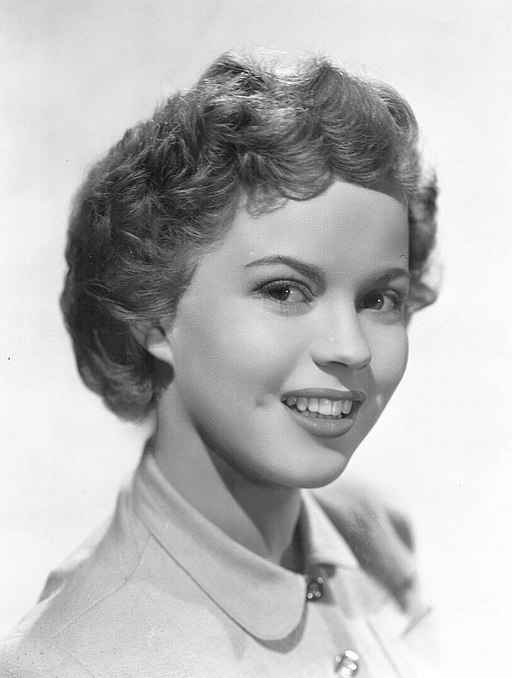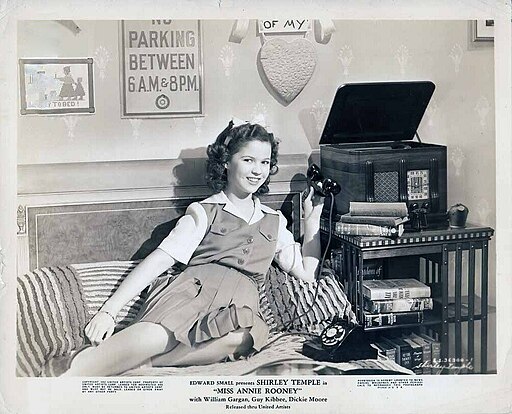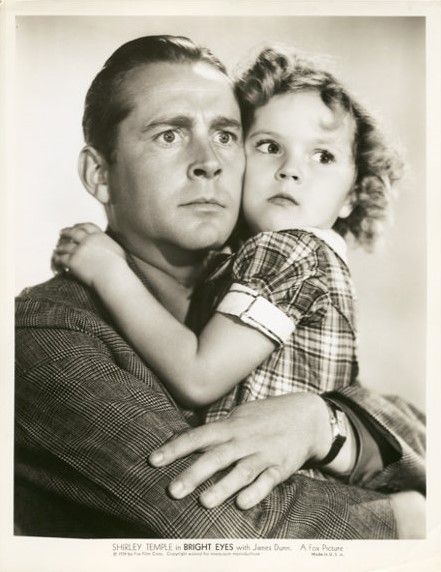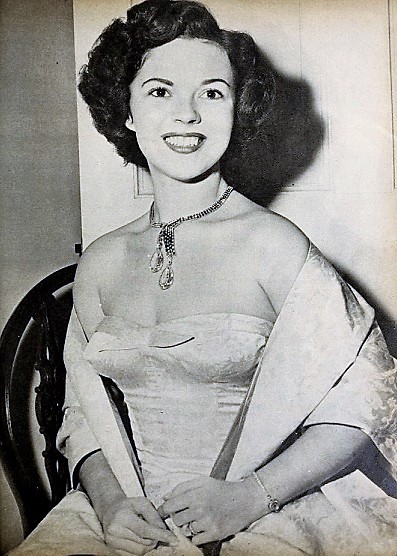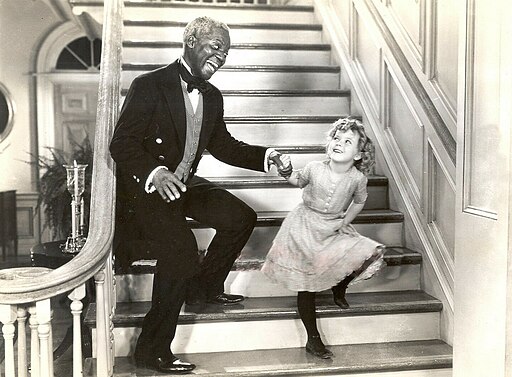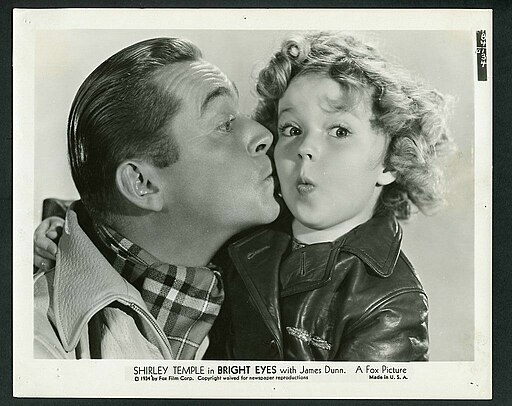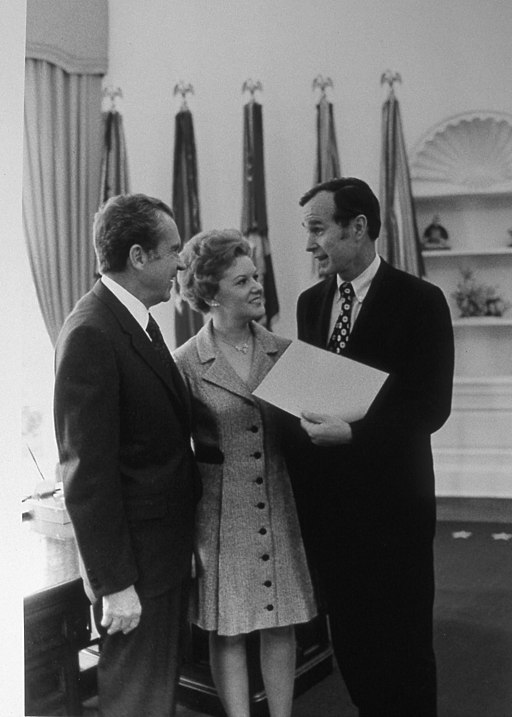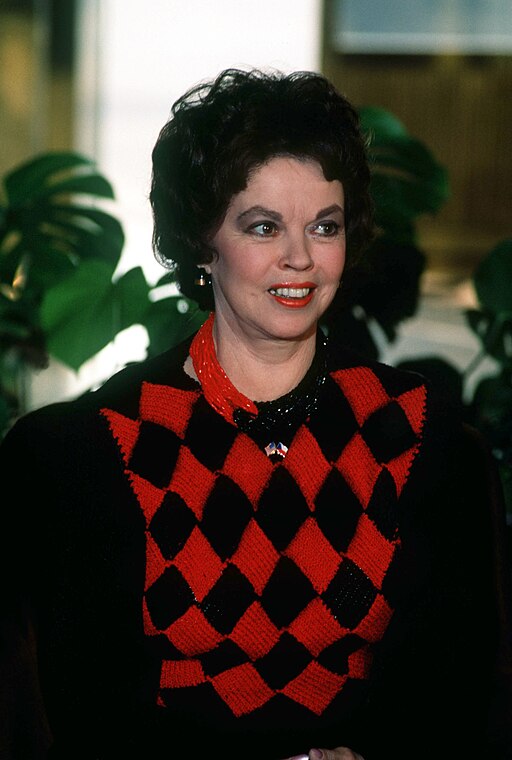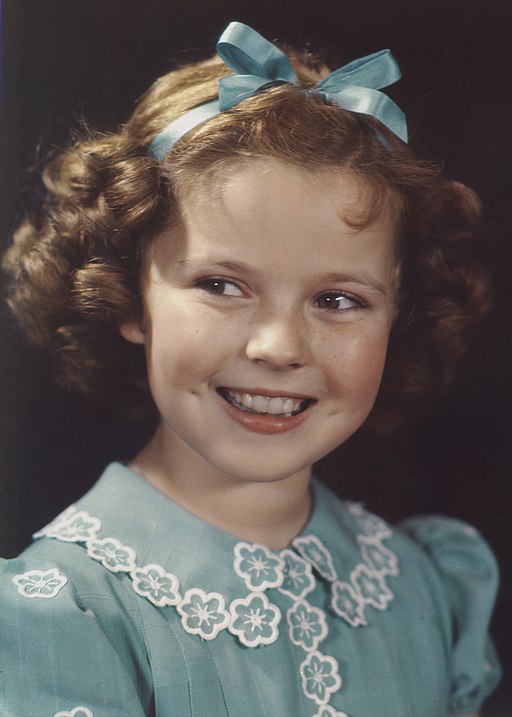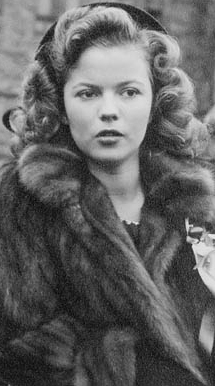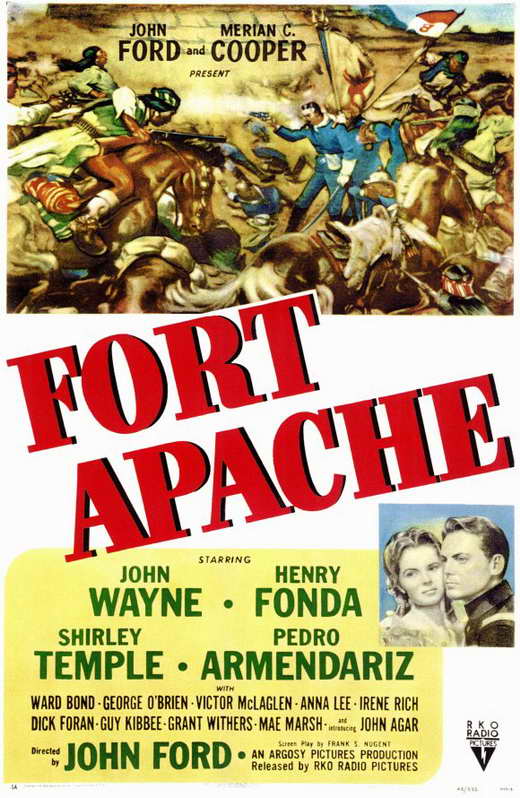Shirley Temple
back| Full Name | Shirley Temple Black |
| Stage Name | Shirley Temple |
| Born | April 23, 1928 |
| Birthplace | Santa Monica, California, U.S.A. |
| Died | February 10, 2014 |
| Buried | Alta Mesa Memorial Park, Palo Alto, California, U.S.A. |
| Married to | John Agar (1945–1950) - Charles Alden Black (1950–2005, his death) |
| Children | Linda Susan Agar (later known as Susan Black) - Charles Alden Black Jr. - Lori Black |
| Notable films | Bright Eyes (1934) - Curly Top (1935) - The Little Colonel (1935) - Heidi (1937) - The Little Princess (1939) |
Shirley Temple
America's Little Darling, a symbol of resilience and optimism
Shirley Temple began her film career at the age of three in 1931. She found international fame with "Bright Eyes" in 1934, becoming known for her singing, dancing, and acting abilities. Her charming, curly-haired appearance and optimistic demeanor in films were a welcome relief during the Great Depression era. Temple was the top box-office draw from 1935 to 1938, a feat unmatched by any other child actor.
In addition to her film career, Temple had a successful career as a diplomat later in life. After retiring from films in 1950, she became active in politics and diplomacy, including roles as the U.S. Ambassador to Ghana and Czechoslovakia, and as the Chief of Protocol of the United States.
Related
Shirley Temple (1928 – 2014)
Biography and Overview of her Career
Shirley Temple was born on April 23, 1928, in Santa Monica, California. She was the daughter of Gertrude Amelia Temple, a homemaker, and George Francis Temple, a bank employee. Shirley's talent for singing, dancing, and acting was apparent from a very young age. Encouraged by her mother, she began dance classes at the age of three.
Her entry into the world of entertainment began with a series of short films called "Baby Burlesks." Her undeniable charisma and dimpled smile quickly caught the attention of Hollywood, and by 1934, she had secured her first major film role in "Stand Up and Cheer!" Her performance in "Bright Eyes" later that year, especially the song "On the Good Ship Lollipop," catapulted her to international fame.
During the Great Depression, Shirley's films were seen as a form of escapism for the American public. She became a symbol of hope and joy during these difficult times, and her films were immensely successful. By the age of six, she was one of the most famous and beloved figures in American culture.
Personal Life and Marriages:
Shirley's personal life was as eventful as her professional one. In 1945, at the age of 17, she married John Agar, an Army Air Corps sergeant and later a fellow actor. The couple had a daughter, Linda Susan, but the marriage ended in divorce in 1950.
Later that year, Shirley married Charles Alden Black, a WWII United States Navy intelligence officer and businessman. This marriage was a happier and longer-lasting union, producing two children: Charles Alden Black Jr. and Lori Black. The family's life was mostly away from the Hollywood spotlight, with Shirley dedicating herself to her family and public service.
Path Towards Success:
Shirley's career was skillfully managed, primarily by her mother, who ensured she was cast in roles that highlighted her talents. Shirley's ability to sing, dance, and act with a maturity beyond her years made her a unique and endearing figure in Hollywood. By the mid-1930s, she was the most popular star in America, known for bringing optimism and happiness to audiences during a time of economic hardship.
Passions and Diplomatic Career:
After retiring from the film industry at the age of 22, Shirley found a new calling in public service and politics. Her passion for diplomacy and politics was evident in her roles as a delegate to the United Nations General Assembly, U.S. Ambassador to Ghana and Czechoslovakia, and the first female Chief of Protocol of the United States. These positions reflected her deep commitment to global issues and her ability to adapt and excel in diverse fields.
Death and Cause of Death:
Shirley Temple Black passed away on February 10, 2014, at the age of 85. She died at her home in Woodside, California, of natural causes, specifically chronic obstructive pulmonary disease (COPD), a condition she battled in her later years, likely exacerbated by a lifelong smoking habit. Her death marked the end of an era, as she was not only a beloved film star but also a respected diplomat and a symbol of resilience and optimism.
Video Tap Dance Scene with Shirley Temple:
Analysis of Shirley Temple’s Acting Style:
Shirley Temple's acting style was characterized by an extraordinary blend of natural charisma, emotional expressiveness, and a maturity that was remarkable for her age. Her style evolved throughout her career, from a precocious child actor to a more nuanced performer in her teenage and adult roles. Here's a more detailed analysis:
- Effervescent Charm and Innocence: From her earliest roles, Temple displayed an innate charm and innocence that instantly endeared her to audiences. Her bright eyes and dimpled smile were more than just physical attributes; they were tools that she used effectively to convey joy, optimism, and resilience.
- Song and Dance Talent: Temple was not just an actor; she was a talented singer and dancer. Her performances in films like "Bright Eyes" and "Curly Top" showcased her ability to handle complex song and dance routines with a seeming effortlessness. Her tap dancing skills, especially her famous stair dance with Bill Robinson in "The Little Colonel," were exceptional.
- Emotional Range Beyond Her Years: Even as a young child, Temple had an uncanny ability to convey a range of emotions. She could move from a heart-wrenching cry to a beaming smile in moments, capturing the emotional essence of her characters. This emotional depth made her performances in dramas as compelling as her roles in more lighthearted films.
- Maturing Style: As she grew older, Temple's roles required a shift from the adorable, curly-haired child to a more mature, nuanced performer. Her ability to adapt to this transition was a testament to her skills. Films like "The Bachelor and the Bobby-Soxer" and "Since You Went Away" showed her tackling more complex emotional and narrative themes.
- Versatility: Temple's teenage roles revealed her versatility. She could play the romantic ingenue, the earnest daughter, or the spirited young woman with equal believability. This versatility hinted at the depth of talent that could have been further explored in more diverse roles.
- Subtlety and Sophistication: In her adult roles, Temple’s acting took on a new level of subtlety and sophistication. While her early career was defined by her ability to command the screen with overt charm, her later performances showed a more restrained, yet equally effective, style.
- Depth of Characterization: Her adult roles allowed her to explore deeper characterizations, moving away from the typecast image of the ever-happy, dancing child. This period showed her capacity for more varied and challenging roles, although opportunities in this realm were limited compared to her early career.
Trivia:
A] Shirley Temple Dolls:
Shirley Temple dolls are among the most iconic and collectible items from the 20th century, reflecting the immense popularity of Shirley Temple as a child star. First produced in the 1930s, these dolls became a must-have item for many fans and collectors. Here's a detailed overview:
Origin and Production:
- Initial Production: The Shirley Temple doll was first produced in 1934, coinciding with the height of her fame as a child actress. These dolls were manufactured by the Ideal Toy and Novelty Company.
- Design and Features: The dolls were designed to resemble Shirley Temple closely, with dimples, curly hair, and a smiling face. They typically wore outfits that replicated the costumes Temple wore in her movies.
Popularity and Impact:
- A Cultural Phenomenon: The dolls were a massive hit, mirroring the popularity of Shirley Temple herself. They became a cultural phenomenon, with children across the United States and elsewhere clamoring to own one.
- Marketing Success: The success of the Shirley Temple dolls is considered one of the earliest examples of using a film star's popularity to market merchandise. This strategy set a precedent for the marketing of celebrity-endorsed products.
Types and Variations:
- Different Sizes and Materials: The dolls were available in various sizes, ranging from smaller, more affordable versions to larger, more elaborate models. They were initially made of composition (a mixture of sawdust, glue, and other materials) and later of vinyl and plastic.
- Costume Variations: Over the years, different versions were released, some wearing costumes from Temple's famous films, like "The Little Colonel" and "Curly Top."
Collectibility:
- Collector's Item: Shirley Temple dolls have become highly collectible. The value of these dolls varies greatly, depending on factors like age, condition, rarity, and originality of clothing and accessories.
- Reproductions and Modern Versions: Due to their popularity, there have been reproductions and modern versions of Shirley Temple dolls. However, original dolls from the 1930s and 1940s are particularly prized by collectors.
Legacy Shirley Temple Dolls:
The Shirley Temple doll is more than a collector's item; it's a piece of cultural history. These dolls represent the immense influence of Temple's persona and the unique way she captured the public's imagination. For many, collecting these dolls is not just about owning a piece of memorabilia but also about connecting to a more innocent, bygone era of Hollywood.
B] Shirley Temple Hairstyle:
Shirley Temple's hairstyle, particularly during her peak years as a child star, became an iconic and defining aspect of her image. Her hairstyle was not just a fashion statement but also a significant part of her charm and appeal. Here's more about her distinctive hairstyle:
The Classic Shirley Temple Curls:
- Ringlet Curls: Shirley Temple's hair was famous for its bouncy, perfectly formed ringlet curls. These curls were tightly wound and evenly spaced, framing her face and enhancing her youthful, cheerful appearance.
- Maintenance: The creation and maintenance of her curls were a meticulous process. Her mother, Gertrude Temple, played a significant role in styling her hair for each movie. It's reported that she would set Shirley's hair in 56 precisely placed ringlets for her movie roles.
- Cultural Impact: Shirley Temple's curls were so popular that they sparked a trend among young girls of the era. Parents would style their daughters' hair to mimic Temple's look, and her hairstyle became a symbol of childhood innocence and charm.
- Hair Accessories: In addition to the curls, her hairstyles often included bows and ribbons, adding to her childlike and endearing image.
Hairstyle as a Part of Her Brand:
- Symbol of Identity: Shirley Temple's curls were more than just a hairstyle; they became a part of her identity and brand as a child star. The hairstyle was instantly recognizable and became synonymous with her name.
- Influence on Fashion: Her hairstyle influenced the fashion of the time, particularly for children's hair styling. The "Shirley Temple curls" became a sought-after look and were emulated in various forms well beyond the 1930s and 1940s.
- Transition with Age: As she grew older, Shirley Temple's hairstyle changed, becoming less about the tight ringlets and more about softer, more natural styles. This transition reflected her maturation from a child star into a teenager and then into adulthood.
Legacy:
Even today, Shirley Temple's hairstyle is remembered as one of the most iconic looks in Hollywood history. It symbolizes a bygone era of cinema and has left a lasting impact on popular culture. The term "Shirley Temple curls" is still used to describe tight, bouncy ringlets, demonstrating the enduring legacy of her unique and beloved hairstyle.
Awards and Recognition:
Shirley Temple, while recognized as one of Hollywood's most iconic child stars, did not amass a long list of competitive awards and nominations in the traditional sense that contemporary actors might. However, her contributions to film and her impact on the industry were recognized in various significant ways. Here's an overview of the key honors and awards she received:
Academy Awards
- Juvenile Academy Award (1935): Shirley Temple was awarded a special miniature Oscar at the age of six for her outstanding contribution to screen entertainment in 1934. This was in recognition of her performances in films like "Bright Eyes," "Stand Up and Cheer," and "Little Miss Marker." This special award was given occasionally to recognize young performers and is one of the early forms of what would later become the Academy's Juvenile Award.
Later Honors
- Kennedy Center Honors (1998): Shirley Temple Black was honored at the Kennedy Center for her contributions to American culture through the performing arts. The Kennedy Center Honors are considered one of the highest honors for cultural contributions in the United States.
- Screen Actors Guild Life Achievement Award (2006): This award is given to an actor or actress to recognize career achievement and humanitarian accomplishment. Shirley Temple Black received this award for her significant career in film and her later diplomatic career.
Other Honors and Recognitions
- Star on the Hollywood Walk of Fame: Shirley Temple has a star on the Hollywood Walk of Fame, a testament to her impact on the film industry. This star is located at 1500 Vine Street, honoring her work in motion pictures.
- National Board of Review Career Achievement Award (1989): This award was given to Temple Black to recognize her lifelong contributions to the film industry.
- Honorary Awards and Recognitions: Throughout her life, Shirley Temple received various other accolades and honorary awards from different organizations, recognizing both her film career and her work in diplomacy.
Memorable Quotes from Shirley Temple:
On Her Early Career:
"I stopped believing in Santa Claus when I was six. Mother took me to see him in a department store and he asked for my autograph."
Reflecting on Stardom:
"When I was 14, I was the oldest I ever was. I've been getting younger ever since."
On Childhood and Fame:
"I class myself with Rin Tin Tin. People in the Depression wanted something to cheer them up, and they fell in love with a dog and a little girl."
Regarding Her Films:
"There's nothing like real love. Nothing." — Shirley Temple in "Bright Eyes" (1934)
On Her Image:
"Any star can be devoured by human adoration, sparkle by sparkle."
About Her Life After Hollywood:
"I have one piece of advice for those of you who want to receive the Lifetime Achievement Award. Start early!"
On Adversity:
"Good luck needs no explanation."
Reflecting on Her Past:
"I have led three lives: the acting part, wife and mother, and international relations. I can't say which I like best. I've loved them all."
On Happiness:
"When I was young, I used to have this thing where I wanted to see everything. I used to think, 'How can I die without seeing every inch of this world?'"
Movies featuring Shirley Temple:
1932
- "Runt Page": A short film where Temple plays a miniature newspaper reporter.
1933
- "The Red-Haired Alibi": Temple's first feature film, where she plays the daughter of a woman involved with a criminal.
- "Out All Night": A comedy where she had a minor role.
- "To the Last Man": A Western film, Temple plays a small part as a pioneer child.
1934
- "Carolina": A family drama set in the South, Temple plays a supporting role.
- "Mandalay": A drama film where Temple appears briefly.
- "Now I'll Tell": A gambling drama, with Temple in a small role.
- "Stand Up and Cheer!": Temple plays a performer who helps lift the nation's spirits.
- "Little Miss Marker": Temple's breakout role as a child left as a marker for a bet.
- "Baby Take a Bow": Temple plays the adorable daughter of an ex-convict trying to live a straight life.
- "Change of Heart": A drama where Temple has a minor role.
- "Bright Eyes": Temple stars as an orphan who brings joy to a pilot and his family.
1935
- "The Little Colonel": Temple plays a young girl who reconciles her family.
- "Our Little Girl": She's a neglected child trying to stop her parents' divorce.
- "Curly Top": Temple plays an orphan who is adopted by a wealthy man.
- "The Littlest Rebel": Temple's character tries to help her Confederate father in the Civil War.
- "Captain January": A lighthouse keeper's tale featuring Temple.
1936
- "Poor Little Rich Girl": Temple plays a rich girl neglected by her father.
- "Dimples": Set in 1850s New York, Temple plays a street performer.
- "Stowaway": Temple's character stows away on a ship and befriends a wealthy man.
1937
- "Wee Willie Winkie": Temple plays a girl who wins over a British outpost in India.
- "Heidi": Temple stars in this adaptation of the classic children's story.
1938
- "Rebecca of Sunnybrook Farm": A musical drama with Temple playing the titular role.
- "Little Miss Broadway": Temple plays an orphan living in a hotel.
- "Just Around the Corner": Temple's character helps her father during the Great Depression.
1939
- "The Little Princess": Temple stars in this adaptation of Frances Hodgson Burnett's novel.
- "Susannah of the Mounties": A Western where Temple's character helps the Mounties.
1940
- "The Blue Bird": A fantasy film featuring Temple in a quest for the Blue Bird of Happiness.
- "Young People": Temple's last film under her 20th Century Fox contract, playing an orphan.
1941
- "Kathleen": Temple plays a teenager dealing with family issues.
- "Miss Annie Rooney": A teenage love story featuring Temple.
1942
- "Since You Went Away": A World War II drama with Temple in a supporting role.
1944
- "I'll Be Seeing You": A drama about a soldier on leave and a woman with a secret.
1945
- "Kiss and Tell": A comedy where Temple plays a teenager causing family uproar.
1947
- "Honeymoon": A romantic comedy with Temple as a newlywed facing humorous challenges.
1948
- "The Bachelor and the Bobby-Soxer": A comedy about a teenager's crush on an older man.
- "Fort Apache": A Western where Temple plays the daughter of a cavalry officer.
1949
- "Adventure in Baltimore": A drama about a young woman aspiring to be an artist.
- "Mr. Belvedere Goes to College": Temple plays a college student in this comedy.
1950
- "The Story of Seabiscuit": A drama with Temple in a fictionalized story of the famous racehorse.
- "A Kiss for Corliss": Temple plays a teenager caught in a romantic triangle.

